Living with histamine intolerance? I’ve cracked the code for delicious Paleo picnic recipes that won’t trigger my symptoms!
My top 7 game-changers are packed with flavor and gut-friendly ingredients. Chicken salad lettuce wraps? Killer. Zucchini noodle salad? Refreshing. Grilled veggie skewers that look like a rainbow? Absolutely.
Sweet potato hummus, coconut flour muffins, and berry chia pudding round out my picnic arsenal. Trust me, eating low-histamine doesn’t mean boring food.
My Low-Histamine Picnic Adventure: A Personal Journey
After years of digestive struggles, I discovered these recipes changed everything.
One summer afternoon, I surprised my skeptical friends with a spread that looked and tasted incredible. Their jaws dropped when I explained everything was low-histamine.
Healing through food isn’t just possible—it’s delicious.
Gut health, autoimmune management, and food sensitivity aren’t limitations. They’re opportunities for culinary creativity.
Chicken Salad Lettuce Wraps

Chicken salad lettuce wraps are a fantastic, healthy choice for the paleo diet. Packed with protein and good fats, they keep you feeling full without the carbs.
However, traditional chicken salad can be problematic for a low histamine diet. Food label mastery helps identify hidden histamine ingredients in store-bought products that could trigger reactions. Ingredients like mayonnaise and certain spices are major offenders. The SIGHI list flags them as restricted for a reason.
Histamine Triggers:
- Mayonnaise (often contains vinegar, a histamine trigger)
- Onion (high in histamine)
- Spices (some can liberate histamine)
To make this dish low in histamine, swap out the high-histamine ingredients for alternatives that fit the SIGHI guidelines.
Low-Histamine swaps
- Replace mayonnaise with coconut yogurt (to avoid vinegar and egg white)
- Use chives instead of onion (low histamine herb)
- Substitute spices with fresh herbs (fresh is better)
Cooking instructions
- Prep the chicken: Cook pure chicken breast until fully cooked. Shred it finely.
- Mix the base: In a bowl, combine shredded chicken and coconut yogurt.
- Add herbs: Chop chives and mix them into the chicken.
- Lettuce wraps: Take large lettuce leaves and spoon the mixture inside.
- Serve: Roll them up and enjoy fresh!
Ingredients
- Pure chicken breast
- Coconut yogurt
- Fresh chives
- Large lettuce leaves
Personal Notes: After experimenting with several batches, I discovered that using coconut yogurt makes this dish taste surprisingly close to the original chicken salad! It’s a game-changer.
Why This Works
- Substituting coconut yogurt offers creaminess without histamine.
- Fresh herbs bring flavor without triggering issues.
- Using lettuce wraps cuts carbs while adding crunch.
Failed Attempts
- Tried using store-bought mayo—huge mistake!
- Added spices, thinking they’d be okay—but they weren’t.
- Used regular yogurt, which bombed in flavor and histamine levels.
Zucchini Noodle Salad
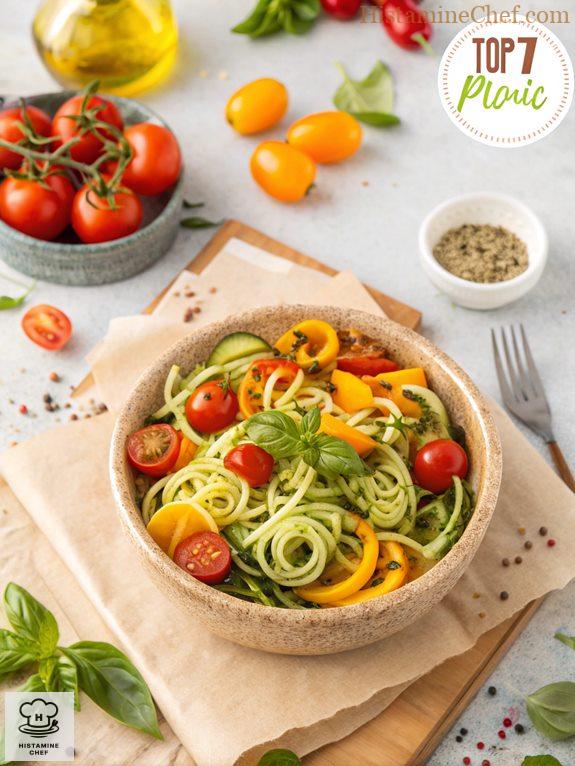
Zucchini noodle salad is a fresh, vibrant dish packed with nutrients. It fits perfectly into the paleo diet, bringing loads of veggies and healthy fats to the table. Making smart recipe swaps helps keep your meals both delicious and histamine-friendly.
But hold up. This salad isn’t low histamine-friendly. It’s got ingredients that’ll make your histamine levels spike. SIGHI list doesn’t play around with what you can and can’t eat.
Histamine Triggers:
- Olives (high histamine)
- Onions (high histamine)
- Tomato (high histamine)
- Fresh herbs like basil (can be liberators)
To make this salad low histamine, swap out the troublesome ingredients for safer options. Trust me, you won’t miss the high histamine stuff.
Low-Histamine swaps:
- Replace olives with diced cucumber
- Swap onions for finely chopped green onions (just the green part)
- Use zucchini instead of any high histamine veggies
Cooking instructions:
- Prepare the zucchini noodles: Use a spiralizer to make noodles from two medium zucchinis.
- Chop the veggies: Dice one cucumber and finely chop the green parts of green onions.
- Mix everything: In a large bowl, combine zucchini noodles, cucumber, and green onions.
- Dress the salad: Drizzle with 2 tablespoons of extra virgin olive oil and a squeeze of lemon juice.
- Serve immediately: Enjoy your fresh salad right away for the best taste.
Ingredients:
- 2 medium zucchinis
- 1 cucumber
- Green part of 2 green onions
- 2 tablespoons extra virgin olive oil
- Squeeze of lemon juice
Personal Notes: I’d to experiment a bit to nail this low histamine version. After a few test batches, I found the perfect balance that tastes just like the original!
Why This Works:
- Zucchini is low histamine and super versatile.
- Cucumber adds crunch without triggering histamine.
- Green onion tops are usually safe, bringing flavor without the harm.
Failed Attempts:
- Using tomatoes made the salad way too spicy.
- Adding olives turned my stomach upside down.
- Experimenting with raw onions was a total disaster.
Grilled Vegetable Skewers
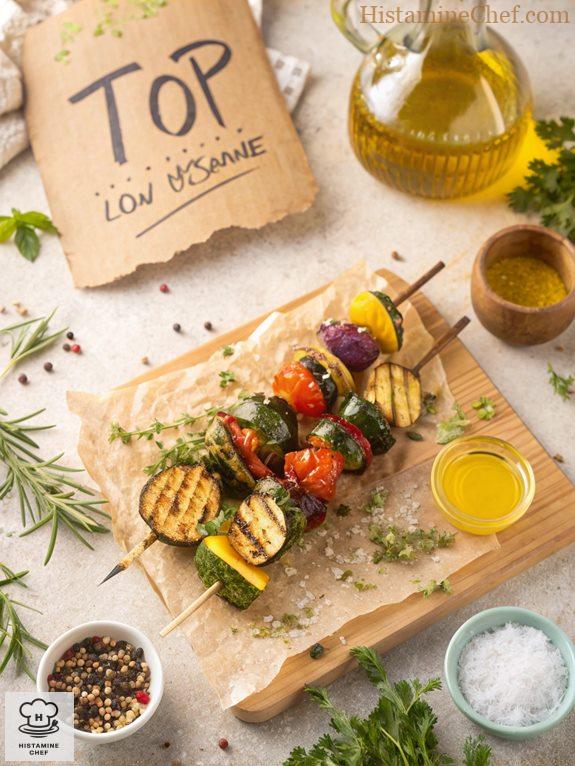
Grilled vegetable skewers are a fantastic addition to the paleo diet. They’re packed with nutrients, low in calories, and bursting with flavor. Plus, who doesn’t love a good charred veggie? When looking for flavor alternatives, consider histamine-safe herbs that can enhance your dish naturally.
But here’s the kicker: a typical grilled vegetable skewer can be a disaster for anyone on a low histamine diet. The SIGHI list warns against several ingredients that can ruin your day.
Histamine Triggers:
- Onions (high histamine)
- Tomatoes (high histamine)
- Mushrooms (high histamine)
- Pickled vegetables (high histamine)
- Olive oil (may irritate sensitive systems)
To transform these skewers into a low-histamine delight, you need to ditch the high-risk ingredients and stick to what’s safe. It’s all about the veggies that won’t mess you up.
Low-Histamine swaps
- Replace onions with zucchini
- Swap tomatoes for bell peppers
- Use fresh herbs instead of any spices
- Ditch mushrooms and go for carrots
Cooking instructions
- Prepare the veggies: Chop zucchini, bell peppers, and carrots into bite-sized pieces. This is your base.
- Skewer the veggies: Thread them onto skewers in any order you like. It’s a free-for-all!
- Drizzle with oil: Use extra virgin olive oil, just a light touch. You want flavor, not a slippery mess.
- Season lightly: Add some fresh herbs for taste, no spices. Keep it simple.
- Grill away: Cook on the grill until the veggies are tender and slightly charred. Yum!
Ingredients
- Zucchini
- Bell peppers (any color)
- Carrots
- Extra virgin olive oil
- Fresh herbs (like basil or parsley)
Personal Notes
After several test batches, I found the secret to making these skewers taste like the original. Fresh herbs and colorful veggies are my go-to. Trust me, they’re delicious!
Why This Works
- Using low histamine veggies keeps your plate safe.
- Fresh herbs add flavor without the triggers.
- Grilling enhances the taste without harmful additives.
Failed Attempts
- Tried using onions and regretted it immediately.
- Swapped with canned veggies – total mistake!
- Over-seasoned with spices, which ruined the balance.
Avocado and Shrimp Cups

Avocado and Shrimp Cups are super healthy. They’re packed with protein and good fats, making them a great fit for the Paleo diet. For those missing cheese, there are dairy-free alternatives that work beautifully in this recipe.
But hold up! Avocado is a big no-no on a low histamine diet. It’s like waving a red flag at a bull. The SIGHI list clearly marks it as restricted.
Histamine Triggers:
- Avocado (high histamine)
- Shrimp (can be problematic if not fresh)
To make this dish safe for low histamine diets, you need to get creative. Let’s swap out the high-histamine ingredients and keep the flavor without the risk.
Low-Histamine swaps:
- Replace avocado with mashed ripe pear (substituting creamy texture)
- Use fresh, frozen shrimp instead of pre-cooked chicken (ensures freshness)
Cooking instructions:
- Prepare the pear: Mash a ripe pear until smooth. This replaces the creamy avocado and keeps it low histamine.
- Cook the shrimp: Sauté fresh shrimp in olive oil until pink. Fresh is key here; frozen works too!
- Assemble the cups: Layer mashed pear and shrimp in small cups. It’s all about presentation!
- Serve chilled: Let it cool before serving to enhance flavors.
Ingredients:
- Ripe pear
- Fresh shrimp
- Extra virgin olive oil
Personal Notes: I discovered the secrets to this dish after a few test batches. It’s amazing how a little creativity can mimic the original taste without the histamine risk.
Why This Works:
- Swapping avocado for pear keeps it creamy without histamine.
- Fresh shrimp maintains flavor while reducing histamine buildup.
Failed Attempts:
- Using pre-cooked shrimp led to off flavors.
- Substituting with avocado compromised the low histamine goal.
Sweet Potato Hummus
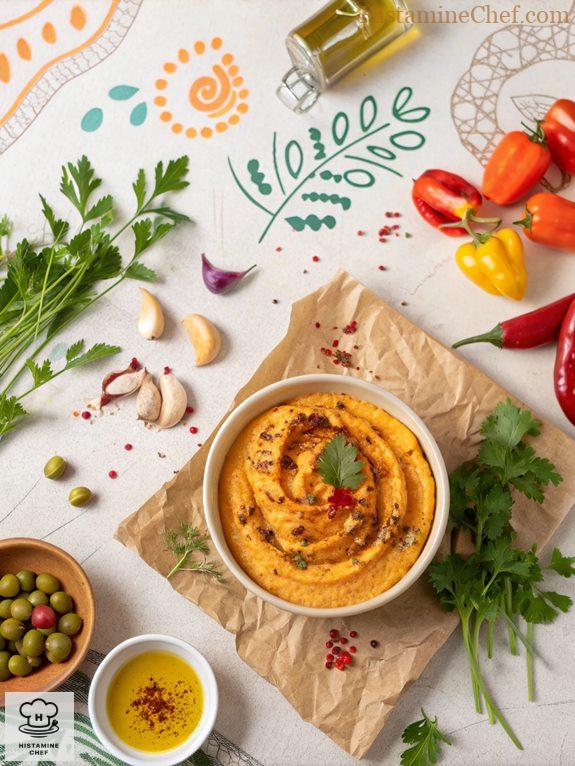
Sweet potato hummus is a creamy, delicious option packed with nutrients. It’s perfect for the paleo diet, offering fiber and vitamins without the grains or processed junk. When making vinegar-free versions, many cooks get creative with acid alternatives to maintain the bright flavor profile.
But let’s get real. Traditional sweet potato hummus doesn’t fit into a low histamine diet. Why? Because it contains ingredients that spark histamine chaos, according to the SIGHI list.
Histamine Triggers:
- Garlic (high histamine)
- Lemon juice (high histamine)
- Tahini (liberator)
To make this dish low histamine, we need to ditch the offenders and replace them with safe options. Trust me, it can still taste great!
Low-Histamine swaps:
- Replace garlic with fresh herbs (for flavor)
- Swap lemon juice for apple cider vinegar (less histamine)
- Use a different nut butter instead of tahini (to avoid liberators)
Cooking instructions:
- Prepare sweet potatoes: Peel and chop two medium sweet potatoes. This makes them easier to cook.
- Boil or steam: Cook the sweet potatoes until tender, about 15 minutes. You want them soft enough to mash.
- Blend ingredients: In a food processor, combine sweet potatoes, 2 tablespoons apple cider vinegar, and fresh herbs. Blend until smooth.
- Adjust seasoning: Taste and add salt as needed. You want it seasoned, but keep it simple.
- Serve: Scoop into a bowl and enjoy with veggie sticks or rice cakes. It’s ready to devour!
Ingredients:
- 2 medium sweet potatoes
- 2 tablespoons apple cider vinegar
- Fresh herbs (like parsley or basil)
- Salt to taste
Personal Notes:
After several test batches, I discovered that fresh herbs work wonders. They give the hummus a vibrant taste without the histamine drama.
Why This Works:
- Sweet potatoes are low histamine.
- Apple cider vinegar is a safe alternative.
- Fresh herbs add flavor without triggering reactions.
Failed Attempts:
- Using lemon juice resulted in headaches.
- Tahini turned out to be a major histamine trigger.
- Garlic made my stomach churn.
Coconut Flour Muffins
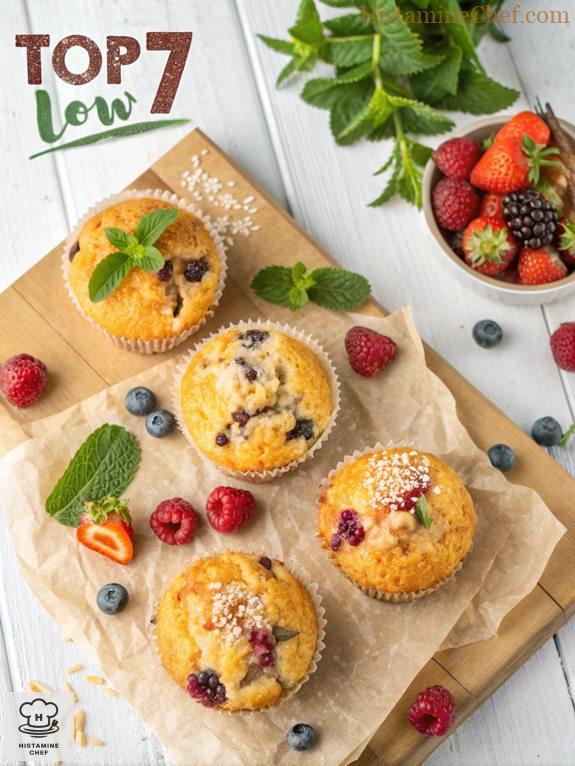
Coconut flour muffins are a great choice for a paleo diet. They’re gluten-free, packed with fiber, and satisfy that sweet tooth without going overboard.
But hold up! In the context of a low histamine diet, these muffins mightn’t be your best friend. Coconut flour can be tricky, and many common muffin ingredients are total red flags on the SIGHI list.
Histamine Triggers:
- Coconut flour (can be a liberator)
- Eggs (raw or cooked egg whites are restricted)
- Baking soda (some might react)
- Any fruits or additives (if high in histamine)
To make coconut flour muffins low in histamine, you need to swap out some ingredients. It’s all about sticking to the SIGHI-approved list.
Low-Histamine swaps
- Use egg yolk instead of whole eggs.
- Substitute coconut flour with almond flour (low histamine).
- Skip baking soda; use baking powder (check for additives).
Cooking instructions
- Preheat your oven: To 350°F (175°C).
- Mix the dry ingredients: Combine almond flour and baking powder in a bowl.
- Prepare the wet mix: In another bowl, whisk egg yolks and honey.
- Combine mixtures: Stir together the dry and wet ingredients until fully blended.
- Scoop into muffin tins: Fill each cup about 2/3 full.
- Bake: For 20-25 minutes, or until golden brown.
- Cool and enjoy: Let them sit for a few minutes before devouring.
Ingredients
- Almond flour
- Baking powder
- Egg yolk
- Honey
- Coconut oil (melted)
Personal Notes
After testing multiple batches, I found the perfect balance that keeps the texture and taste close to the original. Seriously, these muffins are a revelation!
Why This Works:
- Almond flour is low in histamine.
- Egg yolks provide moisture without the histamine risk.
- Honey is a great natural sweetener that’s safe.
Failed Attempts:
- Using whole eggs made the muffins dense.
- Coconut flour alone turned them into a crumbly mess.
- Adding too much honey resulted in an overly sweet disaster.
Berry Chia Pudding
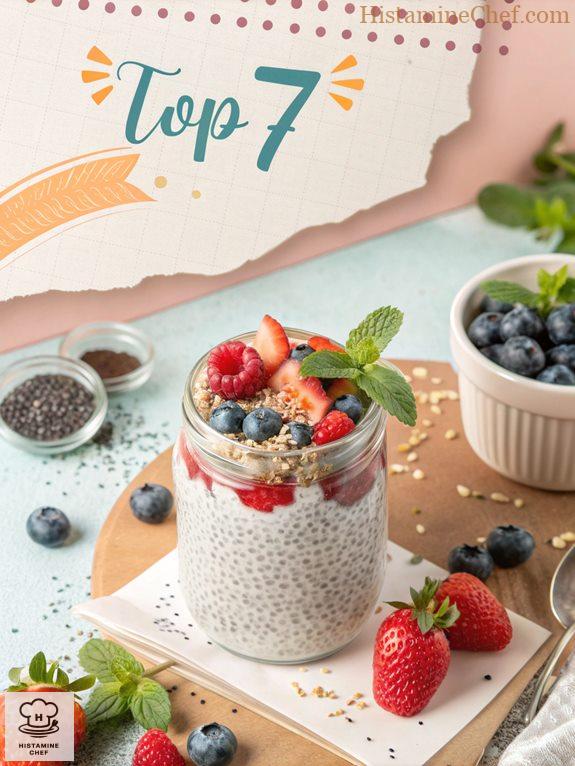
Berry Chia Pudding is a fantastic choice for a paleo diet. It’s packed with healthy fats, fiber, and antioxidants. Plus, it’s super easy to make. Win-win!
But hold up! This Berry Chia Pudding isn’t exactly low histamine friendly. According to the SIGHI list, there are some red flags here.
Histamine Triggers:
- Raspberries (high histamine)
- Strawberries (high histamine)
- Potential sweeteners like honey (depends on your tolerance)
To make this dish suitable for a low histamine diet, I suggest swapping out the high histamine fruits for safer alternatives. We need to keep those histamine levels down!
Low-Histamine swaps:
- Swap raspberries for blueberries (low histamine)
- Swap strawberries for blackberries (low histamine)
- Use agave instead of honey (depends on your tolerance)
Cooking instructions:
- Combine chia seeds and almond milk: Mix together in a bowl.
- This creates the pudding base.
- Add blueberries and blackberries: Stir them into the mixture.
- These berries are low histamine and delicious!
- Sweeten with agave: Drizzle in your choice of agave.
- Adds just the right amount of sweetness.
- Let it sit: Refrigerate for at least 30 minutes.
- This allows the chia seeds to expand and thicken.
- Serve chilled: Give it a good stir before serving.
- Enjoy your tasty low histamine pudding!
Ingredients:
- 1 cup almond milk (low histamine)
- 1/4 cup chia seeds (allowed)
- 1/2 cup blueberries (allowed)
- 1/2 cup blackberries (allowed)
- 1-2 tablespoons agave (allowed)
Personal Notes:
After testing this recipe multiple times, I found that using blueberries and blackberries makes a huge difference. It still tastes fantastic!
Why This Works:
- Blueberries and blackberries are low histamine.
- Chia seeds are packed with omega-3s and fiber.
- Agave is a sweetener that many can tolerate.
Failed Attempts:
- Using strawberries made the pudding too histamine-heavy.
- Substituting with other sweeteners led to digestive issues.
- Not letting it sit long enough resulted in a watery mess.
Low Histamine Food Choices
When it comes to navigating a low histamine diet, it’s essential to zero in on food choices that won’t trigger unwanted reactions.
I love incorporating low histamine grains like quinoa and rice into my meals. They’re not only versatile but also delicious!
Imagine a warm bowl of quinoa topped with fresh blueberries and a drizzle of honey—yum!
When selecting vegetables, stick to the allowed ones like carrots and zucchini. They add crunch and flavor without the histamine hassle.
FAQ
What Are the Symptoms of Histamine Intolerance?
When I experience histamine intolerance, I notice symptoms like headaches, hives, or digestive issues. To manage these, I avoid common histamine sources and focus on a balanced diet that supports my overall health.
How Do I Know if a Food Is Low Histamine?
When I check if a food’s low histamine, I look for clear food labeling and research histamine levels. If it’s fresh and minimally processed, I usually feel safe adding it to my meals.
Can I Combine These Recipes for a Picnic?
Absolutely, I love combining recipes for picnic planning! It’s fun to mix and match different recipe variations. Just make sure they all fit your dietary needs, and you’ll have a delicious and enjoyable picnic!
How Should I Store Leftovers From the Picnic?
Storing leftovers is like tucking away treasures after a day of adventure. For picnic safety, I always use airtight containers and refrigerate them promptly. This keeps my food fresh and minimizes any risk of spoilage.
Are There Any Low Histamine Snacks I Can Add?
I love adding low histamine snacks to my picnic. I usually prepare nutrient-dense options like sliced cucumbers and hummus or almond butter with apple slices. They’re delicious and easy prep, making my picnic stress-free!
Summary
I’ve crafted low-histamine paleo picnic recipes that are simple, nutritious, and delicious. These dishes prove healthy eating can be exciting and effortless, perfect for outdoor dining without compromising wellness.
Have you tried any low-histamine paleo picnic recipes? Share your culinary adventure and favorite dish in the comments below!
Want to spread the low-histamine love? Share this post on your social media and help others discover delicious, health-conscious eating with Histamine Chef!


Leave a Reply